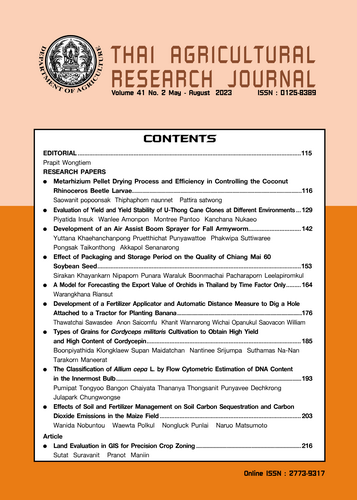The Classification of Allium cepa L. by Flow Cytometric Estimation of DNA Content in the Innermost Bulb
DOI:
https://doi.org/10.14456/thaidoa-agres.2023.17Keywords:
Flow cytometry, nuclear DNA, shallot, onionAbstract
The genus Allium contains more than 920 species. Some species of Allium cannot be identified morphologically. The aim of this project is to assay the DNA content of nuclei of onion, shallot, Indian onion, and potato onion by flow cytometer. The first experiment involved the assay of DNA content of each layer of the onions’ scales. Results showed that the ploidy level was different in each layer of the scales. While most of the innermost scales were diploid, the outer layers contained more of the polyploid nuclei; the farther from the center of the scales, the lesser the diploid nuclei were found. Therefore, in the second experiment, DNA content from the innermost scales of each Allium was investigated. The results clearly differentiated the Allium samples into two groups. The first group included onion and potato onion from Myittha with an average DNA content between 33.53-33.7 pg.2C-1. While the second group included potato onions from Monywa and from Myingyan, shallot (Kanchanaburi), shallot (Lamphun), and Indian onion with an average DNA content between 31.54-32.40 pg.2C-1
References
กรมการค้าต่างประเทศ. 2564. การนำเข้าสินค้าเกษตรตามพันธกรณีความตกลงระหว่างประเทศ. กองบริหารสินค้าข้อตกลงและมาตรการการค้า กรมการค้าต่างประเทศ กระทรวงพาณิชย์. แหล่งข้อมูล: https://dl.parliament.go.th/handle/20.500.13072/599295. สืบค้น: 9 กุมภาพันธ์ 2566.
ธวัช ดอนสกุล และสมเกียรติ พรพิสุทธมาศ. 2553. คาริโอไทปของพืชสกุลหอมกระเทียม 6 ชนิดในประเทศไทย. วารสารมหาวิทยาลัยนเรศวร. 18(1) : 34–39.
นิพนธ์ ไชยมงคล. ม.ป.ป. หอมหัวใหญ่. แหล่งข้อมูล: https://vegetweb.com/wp-content/download/Onions.pdf. สืบค้น: 9 กุมภาพันธ์ 2566.
ศิริยา มากมี และปรีดา นาเทเวทน์. 2559. การศึกษาความหลากหลายทางพันธุกรรมของพันธุ์หอมแดงในเขตภาคเหนือของประเทศไทยด้วยเครื่องหมายโมเลกุล SSR. หน้า 31-38. ใน: การประชุมทางวิชาการของมหาวิทยาลัยเกษตรศาสตร์ ครั้งที่ 54: สาขาพืช, วันที่ 2-5 ก.พ. 2559 . กรุงเทพฯ .
ศิริลักษณ์ อินทะวงศ์ วีณัน บัณฑิตย์ และณัฐา ควรประเสริฐ. 2547. การจำแนกกล้วยไม้สกุลหวายโดยใช้เทคนิคอาร์เอพีดี. วารสารเกษตร. 20 (2): 152−158.
สโรชา อังคปัทมากุล อรุณรัตน์ ฉวีราช ธวัดชัย ธานี และรุ่งลาวัลย์ สุดมูล. 2556. การวิเคราะห์ระดับโมเลกุลและเครื่องหมายดีเอ็นเอแบบบาร์โค้ดของพืชสกุล Allamanda. หน้า 544-554. ใน โครงการประชุมวิชาการเสนอผลงานวิจัยระดับบัณฑิตศึกษา ครั้งที่ 13 มหาวิทยาลัยขอนแก่น. วันที่ 17 กุมพาพันธ์ 2555.
สำนักงานเศรษฐกิจการเกษตร. 2566. 4 พืชหัว กระเทียม-หอมแดง-หอมหัวใหญ่-มันฝรั่ง ปีนี้ให้ผลผลิตเพิ่มขึ้นทุกชนิด ขณะนี้ออกตลาดแล้วจนถึงเมษายนนี้. แหล่งข้อมูล: https://www.oae.go.th/view/1/รายละเอียดข่าว/ข่าว%20สศก.ฝ40689/TH-TH สืบค้น: 9 กุมภาพันธ์ 2566.
Barow, M. and A. Meister. 2002. Lack of correlation between AT frequency and genome size in higher plants and the effect of nonrandomness of base sequences on dye binding. Cytometry. 47: 1−7.
Cousin, A., K. Heel, W.A. Cowling and M. N. Nelson. 2009. An efficient high-throughput flow cytometric method for estimating DNA ploidy level in plants. Cytometry. 75A (12): 1015-1019.
D'Amato, F. 1950. On the occasional occurrence of highly polyploid roots in an onion bulb. Caryologia. 2 : 160−164.
David, W. G. 2009. Simultaneous flow cytometric quantification of plant nuclear DNA contents over the full range of described angiosperm 2C values. Cytometry. 75A (8): 692-698.
Dewitte, W. and J.A.H. Murray. 2003. The plant cell cycle. Annual Review of Plant Biology. 54: 235–264.
Doložel, J., J. Greilhuber and J. Suda. 2007. Flow cytometry with plant cell. Wiley−VCH, Germany. 479 p.
Doložel, J., S. Sgorbati and S. Lucretti. 1992. Comparison of three DNA fluorochromes for flow cytometric estimation of nuclear DNA content in plants. Physiologia Plantarum. 85: 625–631.
Heath, O.V.S. 1945. Formative effects of environmental factors as exemplified in the development of the onion plant. Nature. 155: 623-631.
Johnston, J., D. Bennett, A. Rayburn, W. Galbrith and H. Jame. 1999. Reference standards for determination of DNA content of plant nuclei. American Journal of Botany. 86(5): 609–613.
Jones, W.E., A.R. Kuehnle and K. Arumuganathan. 1998. Nuclear DNA content of 26 orchid (Orchidaceae) genera with emphasis on Dendrobium. Annals of Botany. 82: 189–194.
Kende, H. and J.A.D Zeevaart. 1997. The five classical plant hormones. The Plant Cell. 9: 1197–1210.
Menges, M., A.K. Samland., S. Planchais and J. A.H Murray. 2006. The D-type cyclin CYCD3; 1 is limiting for the G1-to S-phase transition in Arabidopsis. The Plant Cell. 18: 893–906.
Rabinowitch, H.D. and J.L. Brewster. 1990. Onions and Allied Crops. Volume I Botany, Physiology, and Genetics. CRC press, Inc., Florida. 273 p.
Ricroch, A., R. Yockteng., S. Brown. and S. Nadot. 2005. Evolution of genome size across some cultivated Allium species. Genome. 48: 511–520.
Seregin A.P., G. Anačkov and N. Friesen. 2015. Molecular and morphological revision of the Allium saxatile group (Amaryllidaceae): geographical isolation as the driving force of underestimated speciation, Botanical Journal of the Linnean Society. 178 (1): 67–101.
Singh, A.R., S.L. Pankaj and G.N. Singh. 1983. Effect of growth regulators on growth, yield and quality of onion. The Punjab horticultural journal. 23 (1 and 2): 100–103.
Sulistyaningsih, E. and Y. Tashiro. 2003. Determination of ploidy levels of shallot and Japanese bunching onion by flow cytometry. Ilmu Pertanian. 10(1): 9–15.
Traas, J., M. Hulskamp., E. Gendreau and H. Hofte. 1998. Endoreduplication and development. Plant Biology. 1: 498–503
Downloads
Published
How to Cite
Issue
Section
License
Copyright (c) 2023 Thai Agricultural Research Journal

This work is licensed under a Creative Commons Attribution-NonCommercial-NoDerivatives 4.0 International License.
Thai Agricultural Research Journal



